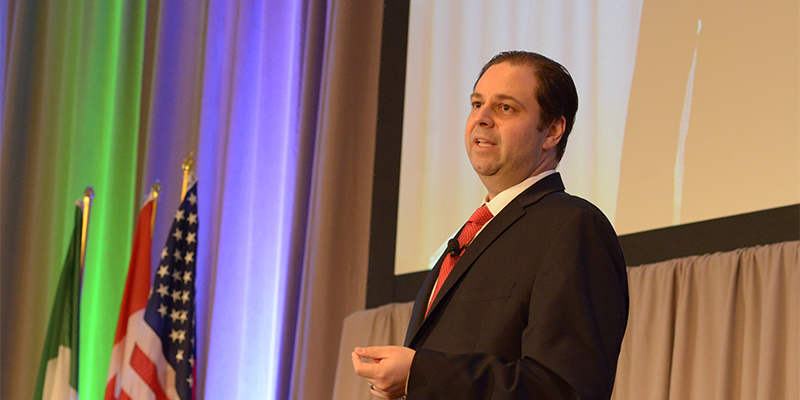In his keynote address at I.CON East 2019, Joshua Harris, vice president of strategy at Skanska USA Commercial Development, provided insight into the state of the economy and key trends affecting the industrial real estate market.
After noting that NAIOP has played an important role in his career including through his involvement as an elite NAIOP Distinguished Fellow, Harris began his presentation with an assessment of the state of the economy. Odds of a recession have significantly increased with recent developments, but it is still unclear whether the economy will enter a recession, will return to growth, or will experience a “micro-recession” of reduced business investment and slower growth that falls short of two full quarters of economic contraction. Harris pointed out that the economy already experienced one of these slowdowns in 2015-2016 due to the oil slump, but that the slowdown proved transitory.
Harris identified several factors suggesting that a recession might be near. The trade war has rattled the business community and may dampen consumer spending. Global market uncertainty is high with events like the Hong Kong protests and Brexit leading to capital flight in international markets. CEO confidence has recently declined. Harris is most concerned about declining business investment, which dipped into negative territory (-1.1%) in the second quarter. He predicts that if business investment turns sharply negative in the next quarter, it will be a clear indication that the economy is headed into a recession, but if business investment rebounds, we can expect continued economic growth.
On the other hand, Harris noted that there are several positive economic trends that may keep the expansion going. The labor market remains healthy, with more job openings than unemployed workers. U.S. consumers are faring well, with relatively high savings rates and healthy debt loads. Interest rates are low, with a flat or negative outlook, which should benefit the commercial real estate industry. And, in comparison with much of the rest of the world, the United States is relatively stable. Many of the investors that have divested from markets like the United Kingdom have parked their money in U.S. bonds.
Whether or not the U.S. economy enters a recession in the near future, slowing growth has already impacted the market for industrial real estate, leading NAIOP to lower its third-quarter Industrial Space Demand Forecast from its previous estimate. The forecast now projects quarterly absorption of around 37 million square feet of industrial space per quarter, down from the previous projection of about 60 million square feet per quarter.
It remains to be seen whether a recession is on the horizon, but Harris observed that there are many reasons to be optimistic about the long-term prospects for industrial real estate. Harris noted that “industrial is one of the most dynamic and interesting parts of commercial real estate.” Much of this dynamism can be attributed to the evolution of the industrial market with the arrival of what Harris calls “Industrial 2.0.”
Harris maintained that while more traditional industrial development (“Industrial 1.0”) continues to be anchored by manufacturing and trade routes, “increasingly to understand industrial, we need to understand consumers.” With the expansion of demand for industrial real estate from the growth of e-commerce, a new segment of the industrial market has arisen to serve retailers who ship directly to consumers. This “Industrial 2.0” market faces different demand drivers than traditional industrial development. It is less sensitive to the business cycle but is more sensitive to demographics. It benefits more from proximity to people than proximity to trade routes or manufacturing. Industrial 2.0 buildings generally require more flexible configurations than traditional buildings, and often require more innovative features.
While Harris thinks that the development community has mastered traditional industrial development, he observed that the commercial real estate industry is still figuring out Industrial 2.0, which continues to evolve. For example, while we can reasonably predict that new technologies – such as 5G, the internet of things, and automation – will significantly affect industrial development, these technologies will take time to mature and be widely adopted.
Looking beyond a recent increase in economic uncertainty, Harris remains optimistic about the long-term prospects for the economy and industrial real estate. He expects that labor market shortages will continue and that demand will continue to grow for one-day delivery. The next decade could be this century’s “Roaring ‘20s.”
This post is brought to you by JLL, the Social Media and Conference Blog sponsor of NAIOP’s I.CON East: The Industrial Conference. Learn more about JLL at www.us.jll.com or www.jll.ca.















